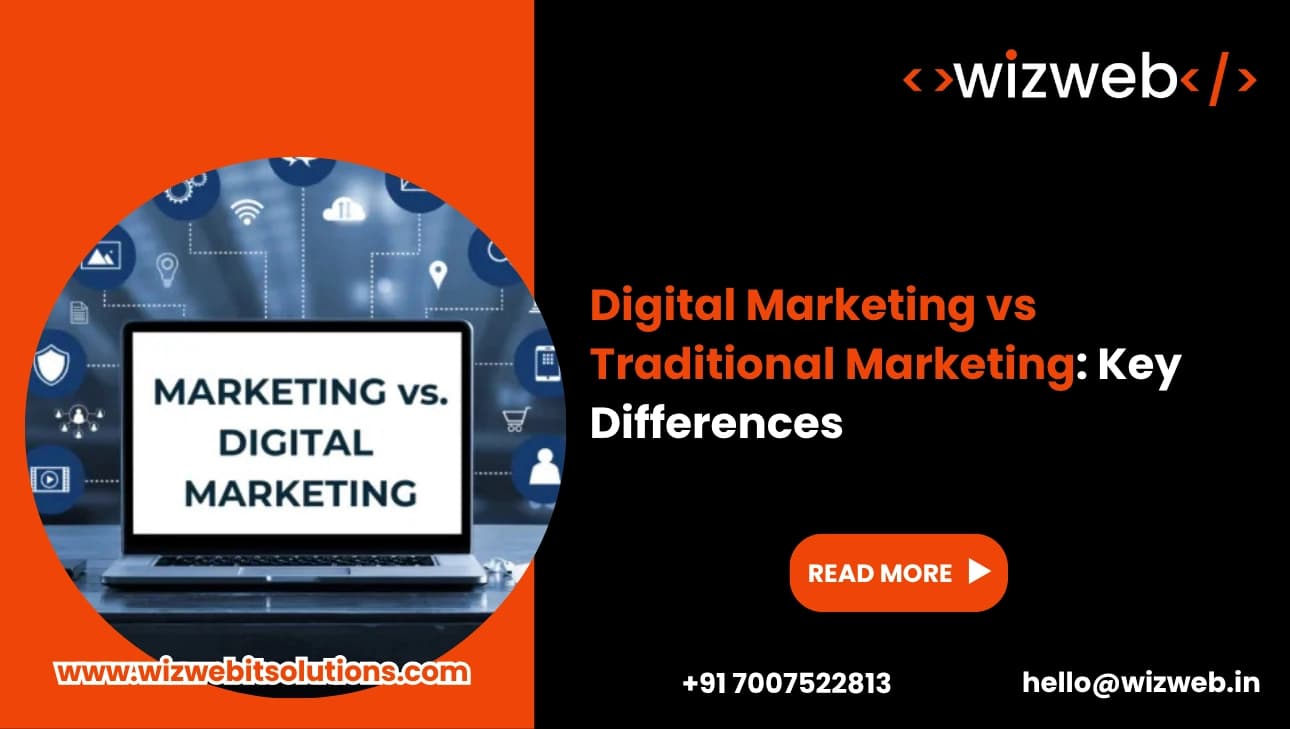Get in Touch
- Phone
+91 700 752 2813
- Email Now
hello@wizweb.in
Office No - 204 A-140, Sector 63 Road Noida, Uttar Pradesh 201301

In today’s fast-changing world, every business wants to grow. Whether you run a small bakery in your town or own an online clothing store, marketing is what helps people know about your business. But there’s always one big question that comes up — Digital Marketing vs Traditional Marketing: which is better?
This is a very important topic because how you promote your products or services can decide how many customers you get. In this article, we’ll talk about Digital Marketing vs Traditional Marketing, look at their key differences, their pros and cons, and help you understand which one might be the best for your business.
Let’s start with traditional marketing. It is the oldest and most common way of advertising. It includes things like:
– Ads in newspapers and magazines
– TV and radio commercials
– Posters, hoardings, and billboards on the road
– Flyers, brochures, and direct mail delivered to your home
For many years, these methods were the only way businesses could reach people. If you remember your parents reading newspaper ads about discount sales or watching TV ads about soap, that’s traditional marketing. It feels familiar, trusted, and many people, especially older audiences, still like it.
Now let’s understand the other side in Digital Marketing vs Traditional Marketing — digital marketing. This means promoting your business on the internet and through digital devices. It includes:
– Social media marketing (like posts on Instagram, Facebook, LinkedIn)
– Email marketing (sending offers and newsletters)
– SEO (making sure your website appears on Google when people search)
– Paid ads on Google, Facebook, YouTube
– Blogs, videos, and other online content
Imagine you search “best shoes for walking” on Google, and a website pops up. Or you see a Facebook ad for a new pizza place. That’s digital marketing.
When we compare Digital Marketing vs Traditional Marketing, we see they are very different in how they work, what they cost, and how they reach people.
| Aspect | Traditional Marketing | Digital Marketing |
| Medium | Newspapers, TV, radio, billboards | Internet, social media, email |
| Cost | Usually high | Can be low and scalable |
| Reach | Mostly local or mass broad audience | Local plus global, highly targeted |
| Tracking | Difficult to measure | Easy to track with data & reports |
| Flexibility | Not changeable after launch | Can change anytime instantly |
| Interaction | One-way — you talk, customers listen | Two-way — customers can comment, share, reply |
This shows why so many businesses today use Digital Marketing Services to take advantage of these benefits.
Absolutely! In fact, that’s what many smart businesses do. They mix both strategies.
For example:
– A local gym might put banners around the city (traditional) but also run Instagram ads showing their workout sessions (digital).
– A restaurant may give flyers in the neighborhood (traditional) and post daily food pictures on Facebook (digital).
This way, they get the trust and familiarity of traditional marketing and the wider reach plus tracking of digital marketing.
When deciding on Digital Marketing vs Traditional Marketing, think about:
One big reason is that digital gives you power to measure everything. You know how many people saw your ad, clicked it, and bought your product. With traditional marketing, it’s often just a guess.
Also, with digital, you can run multiple small campaigns, try different ads, see what works, and adjust. This is why so many companies invest in Digital Marketing Services to handle their SEO, social media, and paid ads.
At the end of the day, it’s not really about Digital Marketing vs Traditional Marketing being enemies. Both have their place.
If you have the budget and your audience is broad, you can run a nice combination — a TV ad plus a strong Instagram page. If you’re starting small, digital marketing gives you tools that are affordable, measurable, and flexible.
So, before choosing, take a moment to think about your business goals, your audience, and your budget. This way, you’ll know if you should stick to old-school methods, go fully digital, or do a bit of both.